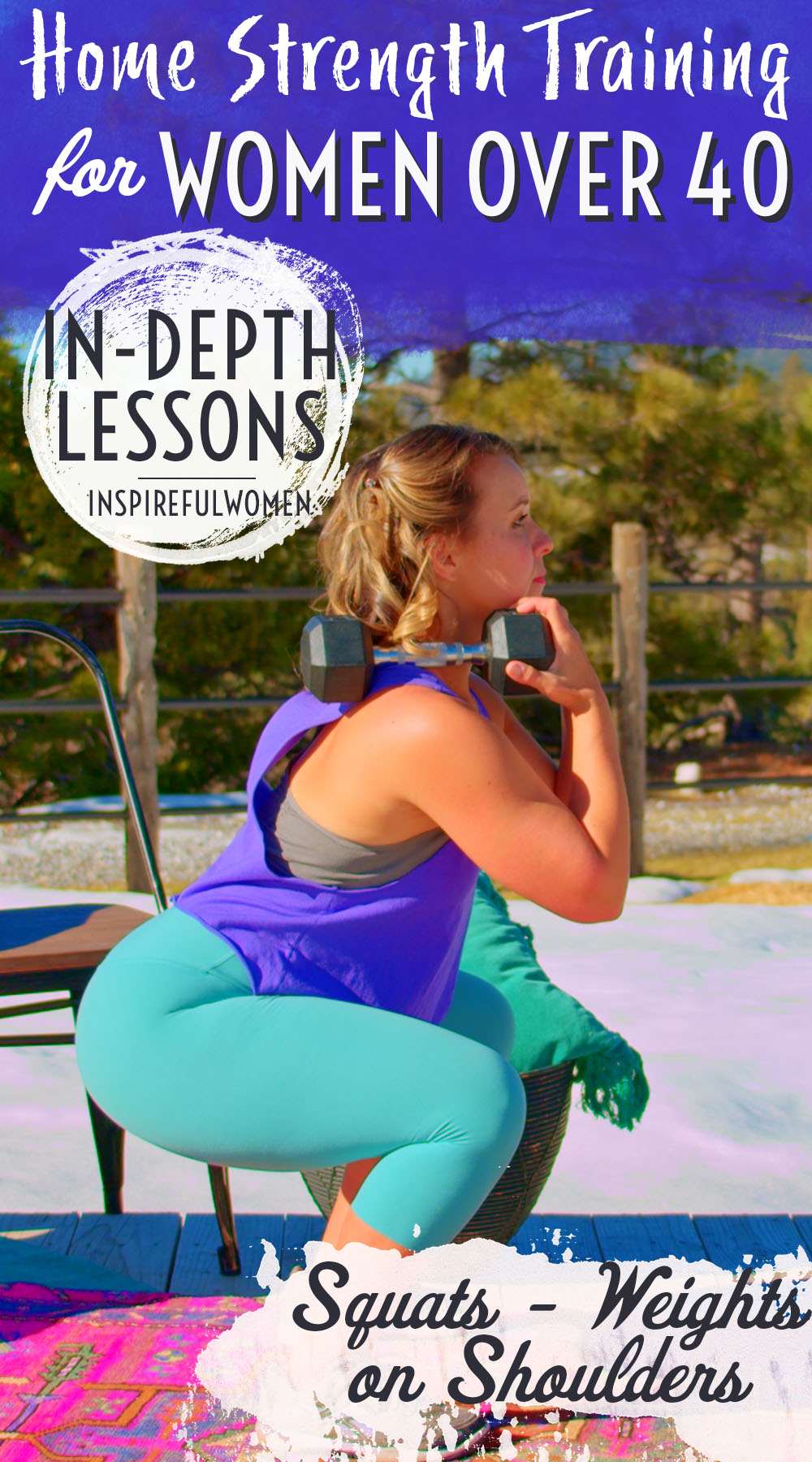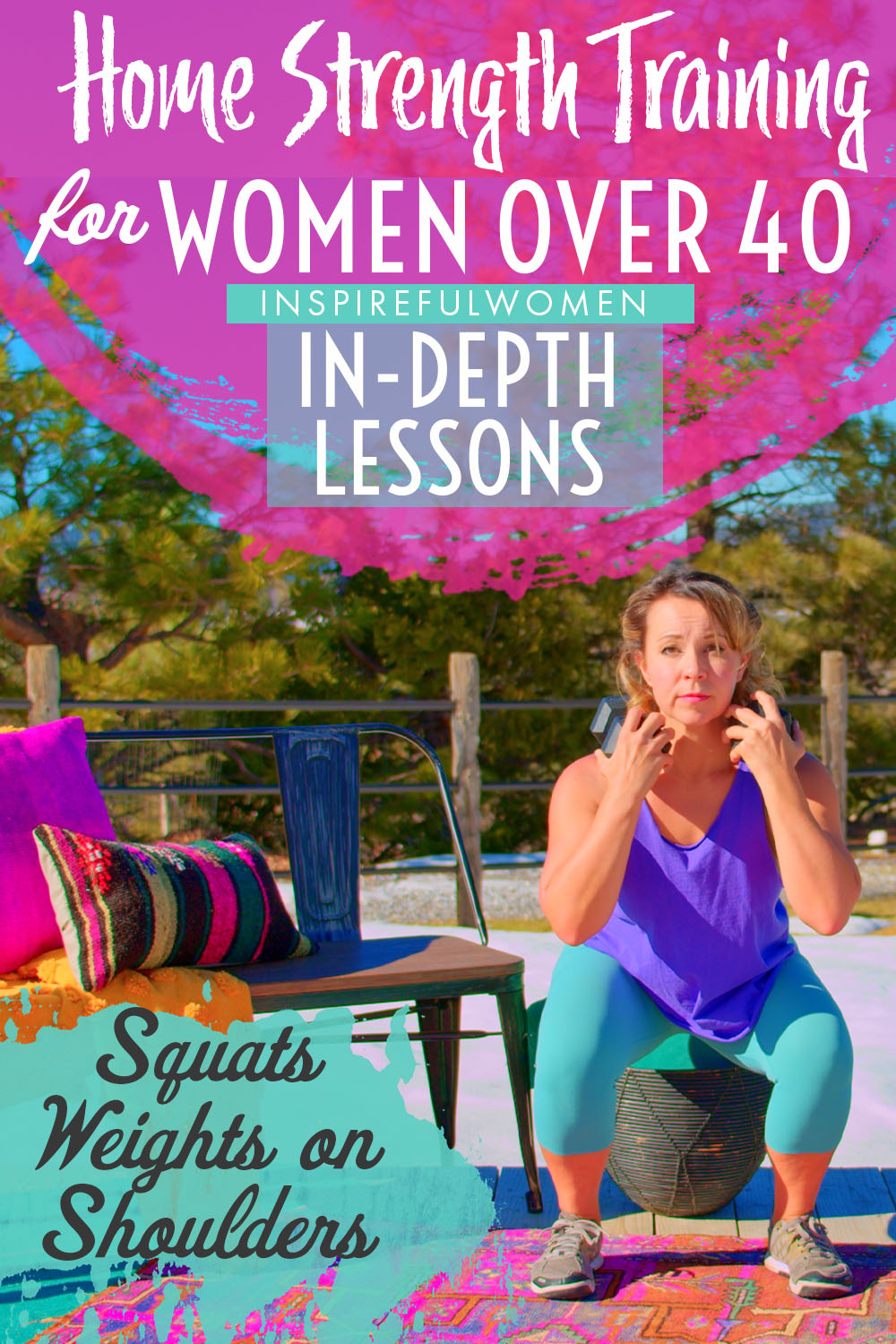DUMBBELL SQUATS
How to Do Dumbbell Squats - Weight on Shoulders | In-Depth Guide [VISUAL LEARNERS] Beginner
Proper Form & Common Mistakes | Home Resistance Training
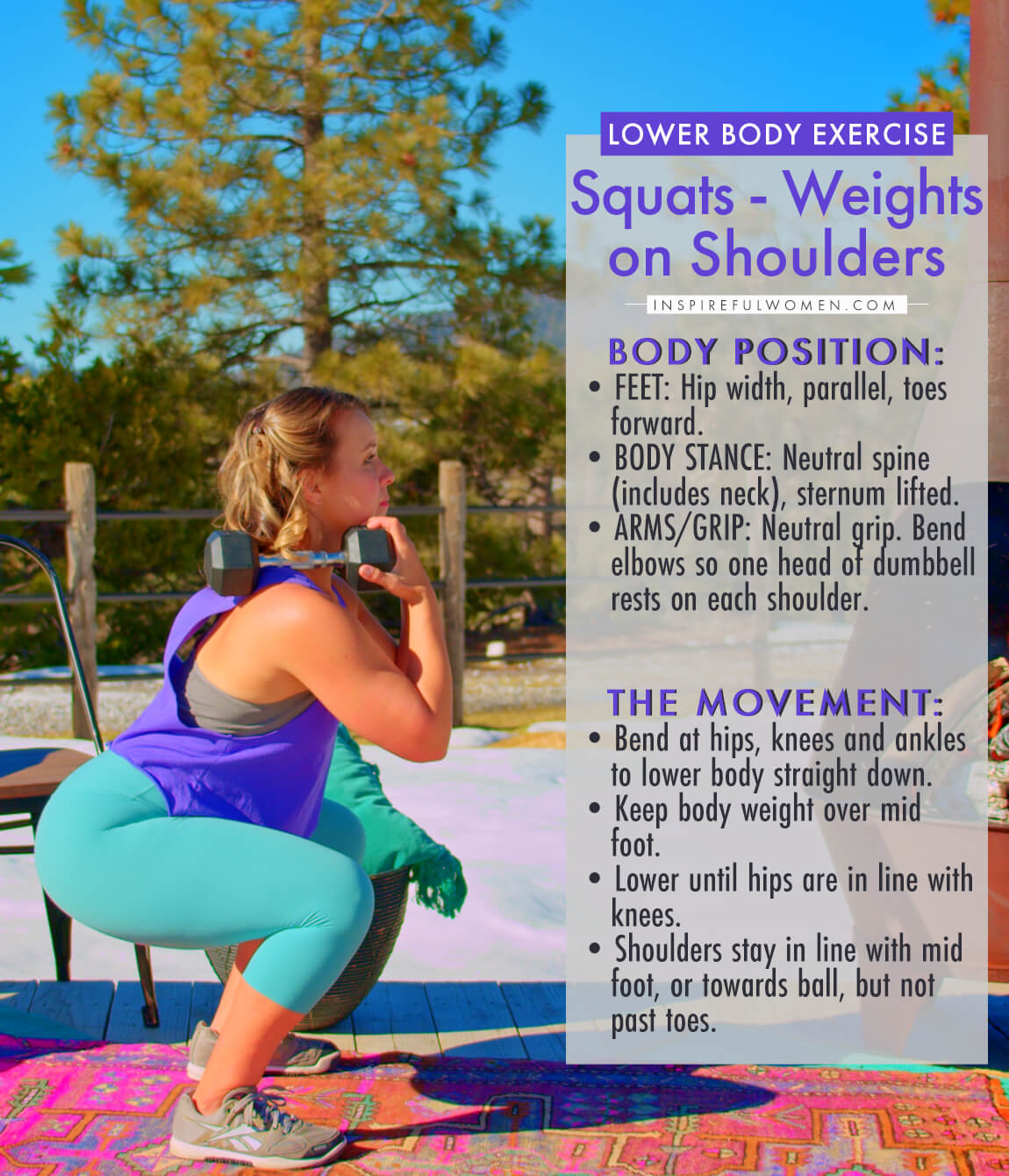
WHAT DO YOU WANT TO SEE?
QUICK DEMO
QUICK DEMO
MUSCLES THIS WORKS
MUSCLES
MAIN MUSCLES WORKED IN Squats - Weights on Shoulders
Quadriceps & Gluteus Maximus
OTHER MUSCLES WORKED:
- Gastroc/Soleus
- Hamstrings
- Erector Spinae
WHAT WE'RE DOING TODAY
WHAT & WHY
BENEFITS OF TRAINING THE Quadriceps & Gluteus Maximus
WHAT
WHAT WE'RE DOING TODAY
ALL WE'RE DOING:
Squats are one of those things we all think we know but there's some good pointers worth watching the video for.
Doing a squat with weights at home is an important way to build true muscle when strength training at home over 40. These are big muscles we're working and they need a fair amount of resistance to work against.
Adding resistance to squats can improve your ability to lift more weight. This is useful for everyday life, like lifting kids, heavy bags, moving furniture, and many other daily tasks. It also can help you lift more with your deadlifts, lunges, and split squats. It is important that you are able to do a basic bodyweight squat with good form before adding resistance. Just remember to add the resistance very gradually, always paying attention to how it feels - both during and after (that day and the next day) the exercise, and your form. Make sure to take into consideration how you are holding the weight. There is a big difference between holding the weight close to your body and holding the weight out to the front or over your head.
There may be a tradeoff when you add resistance to your squats. Sometimes when you use resistance you aren’t able to squat as deep. This is fine if you are just starting out and plan on working on going more deeply into the squat with time, or if you want to work on improving your leg strength in a smaller range of motion. It is always important to think about your personal goals for the exercise before choosing which version of squat you want to do.
When deciding on how far to squat down, keep in mind that the quadriceps muscles - the big muscle on the front of the thigh, will be most active when your thighs are parallel to the floor. If your goal is bigger, stronger thigh muscles, stopping when the thighs are parallel to the floor would be a good option. If your goal is to improve your leg strength through the whole range of motion and also enough movement at the ankles, hips and knees. If this is your goal, you can lower down as far as you are able while maintaining good form.
No matter what your goals are for the squat, the limiting factors are the same - you must be able to do the movement with good form. What is good form?
- Try to keep the upper body parallel with the shin (tibia) - towards being vertical.
- Shoulders over the feet.
- Knees are aligned over feet - the front of the knee will move forward towards the toes, but it should not be collapsing in or leaning out.
- Feet are flat on the floor (not rolling up to toes, or to the inside or outside of the foot) and toes pointing forward - this will improve the movement in the ankles and use the calf muscles more.
If you are struggling with any one of these limitations, return to body weight or assisted squats. Adding resistance with poor form can result in injury or damage to the joints over time.
Keeping the small curve in the low back as you squat down can be hard for a lot of people. It may be helpful to actively pull yourself down at the beginning of the squat. One of the hip flexors (iliopsoas) is attached to the low back (the lumbar part of the spine). Activating these muscles can make it easier to hold the low back in a neutral position.
WHY BOTHER DOING IT?
WHY
WHY DO WE EVEN CARE?
GET FOR REAL MUSCLE
Squats should be a staple in the lower body workout. Adding resistance to the exercise is an effective, and usually safe, way to challenge your leg muscles. Squats target some of the biggest leg muscles, and have the added bonuses of strengthening the core and improving the mobility of the ankles, hips and thoracic spine at the same time. The target muscles of the legs are powerful muscles, training these muscles can increase running speed and endurance. Increasing the strength of the lower body and core will help to lift more weight with the upper body by providing a strong and stable base to work from.
PROTECT AGAINST DAMAGE TO JOINTS AS WE AGE
Adding resistance to squats helps to prevent damage to the ankle, knee, hip and back joints and soft tissues. Using the legs to lift heavy weight requires the muscles to hold the joints stable under the load. If you were only to do body weight exercises then the muscles would be capable of stabilizing against body weight. Once you add a load, the muscles need to be stronger to keep the legs and spine in good alignment. Thinking about your daily activities can help plan your goals for resisted squats. If you routinely pick up a 45 pound child or bag of dog food, then you would want to work towards being able to lift that amount of weight while squatting with good form.
EVERYDAY LIFE
EVERYDAY LIFE &
MUSCLE FUNCTION
HOW WE USE OUR Quadriceps & Gluteus Maximus IN EVERYDAY LIFE
THE QUADRICEPS AND GLUTEUS MAXIMUS MUSCLES WORK TOGETHER IN ACTIVITIES THAT INVOLVE STRAIGHTENING THE KNEE AND THE HIP AT THE SAME TIME.
1. Jumping
2. Climbing
3. Going up and down stairs
4. Transitioning sit to stand to sit
- Sitting in chairs
- In and out of cars
- On and off of toilet
5. Squatting down/getting up
- Getting things out of the bottom shelf
- Getting up and down from the floor
- Gardening
- Picking items or kids up
6. Shock absorbers to protect the ankle, knee, and hip joints during:
- Walking
- Running
- Jumping
7. Stabilizes the knee joint during all activity that involves bending and straightening the knee
8. Positions the kneecap in the groove of the femur during knee movement
STARTING POINTERS
Starting Pointers
Because the weight is higher up on the torso you can lean back a little bit and the front head acts like a small counterbalance. This is a nice option if you struggle to keep your torso more upright in a squat - the dumbbells hanging from your hands will not give you this advantage if you struggle with that issue.
You should be able to complete a basic squat with good form before adding weight. Remember that you may need to limit how far you lower down into the squat when you add weights. Your form will dictate how low you go, keep the torso and shins close to vertical, the weight distributed on your entire foot, shoulders over midfoot/arch, and knees in line with toes. If you are new to squats with resistance, resist the urge to use a lot of weight, start light, make sure your form is right and progress slowly.
Holding the weights on the shoulders can help to shift the center of mass forward a little bit. This can make it easier to keep your torso upright as you squat without falling backward.
The dumbbells will increase the eccentric work done by the leg muscles to control the movement as you lower down into the squat and also the concentric activity as you press back up into standing.
HOW TO FEEL WHAT MUSCLE IS WORKING
How to Feel What Muscle is Working
Quadriceps: Sitting upright, place your hand on the front of your thigh (of the test leg). Hook the ankle of the other leg to hold the test leg (the leg that your hand is resting on) in place. Try to straighten the test leg by lifting the foot. You will feel your quadriceps contract.
Gluteus Maximus: Place your hands on your bottom - about where they would be if you put your hands in your back pockets - with the palms on your buttocks. Push down into both feet as if you were pressing yourself up to standing. Try to keep the front of your thighs relaxed so that the muscles under your hands contract. Try activating only one side at a time.
HOW TO DO THE EXERCISE
LOOKS
HOW Squats - Weights on Shoulders SHAPE OUR BODY
Firm and shapely thighs and buttocks.
PROPER FORM
PROPER FORM: Squats - Weights on Shoulders
EQUIPMENT, SETS & REPS
EQUIPMENT
SUGGESTED STARTING WEIGHT FOR WOMEN:
5 - 8 lbs in each hand
SETS & REPS:
2 sets of 8 reps
PACE:
Controlled, up can be quicker than down.
BODY POSITION
BODY POSITION FOR THE Squat - Weights on Shoulders
FEET: Hip-width apart, toes forward. *If you have pinching in the front of your hip go ahead and point your toes out to a position where there is no pinching.
BODY STANCE: Neutral spine (includes neck), sternum lifted, shoulders back with shoulder blades back and down. Legs straight, knees soft.
ARMS/GRIP : Hold one dumbbell in each hand with a neutral grip. Curl the dumbbells, one at a time, so that the end closest to you is resting slightly on your shoulders.
HOW TO DO
HOW TO DO Squats - Weights on Shoulders
CUE: You should feel like you are lowering straight down, folding at your ankles, knees and hips.
Actively pull your trunk down as you bend at hips, knees and ankles to lower your body down into a squat.
Lower until your hips are in line with your knees. It is ok to go lower if you can keep your spine in neutral, your torso and shins towards vertical (as upright as possible) and parallel, your weight over your entire foot, and your knees in line with your toes; no pain or discomfort and the movement is controlled. The path of your shoulders, viewed from the side, should ideally always be headed straight down, or where your shoulders stay in line with the mid foot, or towards the ball, but not past the ball of your foot or toes- at this point your center of gravity has moved too far forward.
To return to standing, push into your feet, straighten your ankles, knees and hips.
HOW TO SAFELY GET OUT OF THE EXERCISE
From standing, squat and lower the weights to the floor.

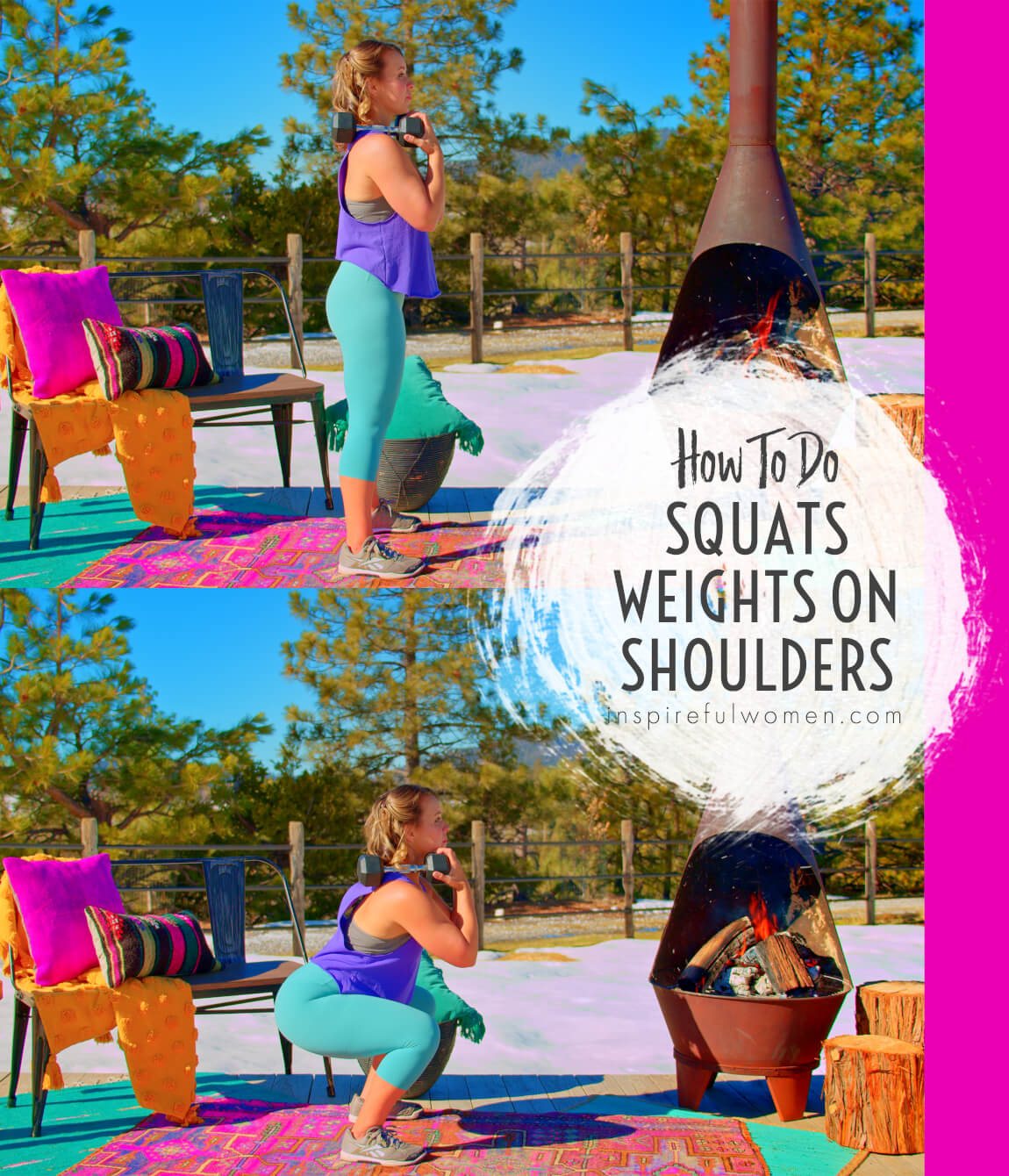
COMMON MISTAKES
COMMON MISTAKES
WHAT TO AVOID WITH Squats - Weights on Shoulders
KEY TIP:
Guess what? Good news! Many avoids are the same for most movements. Once you learn the basics, there's really only a few extra avoids for each individual movement.
1. Avoid Rounding Low Back
AVOID: Rounding your back or "tucking your tail"
WHY NOT?
- This is the most common mistake made, in an attempt to go deeper into the squat the tailbone is tucked under.
- This can lead to increased pressure on the spine, and lead to injury or damage over time.
- Tucking the tail, and rounding the low back defeats the purpose of going deeper into the squat.
- The goal for going deeper is to strengthen the core and increase the range of motion of the hips and ankles.
- Tucking the pelvis under does not increase the hip or ankle range of motion.
WHAT TO DO:
- Keep your spine from head to tailbone in neutral throughout the movement.
- Keep your shoulders back and sternum lifted.
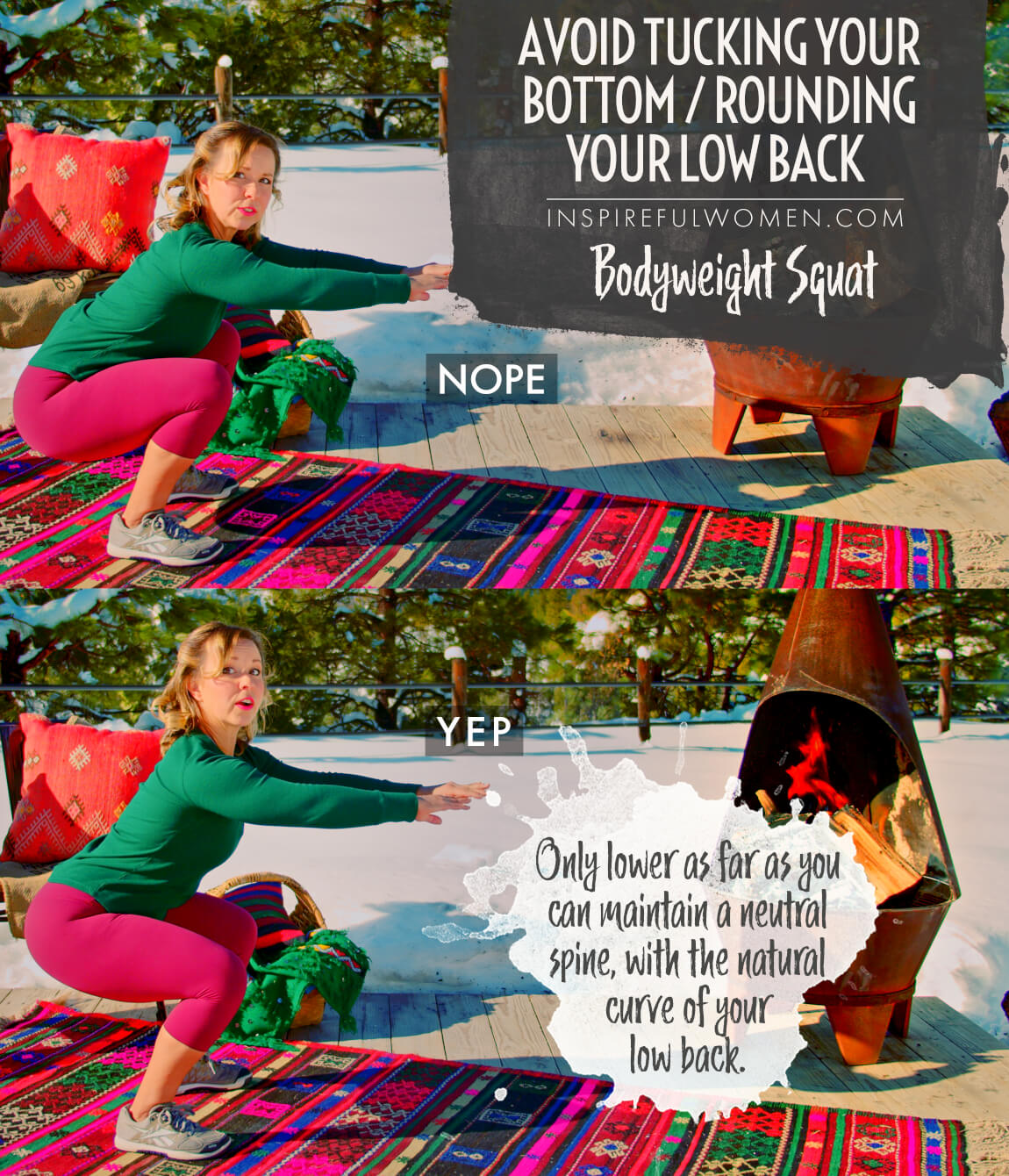
2. Avoid Shifting Weight Forward To Toes
AVOID: Shifting the weight forward/rolling up onto the balls of the feet.
WHY NOT?
- This shifts your center of gravity forward and increases the forces on the front of the knee.
- It can also cause you to round your back.
WHAT TO DO:
- Keep your heels down- you should feel the entire ball of the foot and heel on the floor (the arch is lifted).
- If you cannot keep the heel down:
- Work on increasing the flexibility of your ankle joint. In half-kneeling, the front foot flat on floor, shift the body weight forward to bend at the ankle. You should be able to get the knee about 4 inches past the toes. If not, go to where it feels tight and pulse forward a few times and then hold for 5 seconds when the ankle is most bent. Repeat 5 times.
-
- Stretch your calf muscles (both the gastrocnemius and the soleus). Stand facing the wall, put one foot forward, toes touching the wall, knee bent slightly, hands on the wall. Other leg back about 12 inches (behind the heel of the front foot), heel down, toes facing forward (not toeing out). Bend elbows to lean forward, keeping the heel of the back foot down. You should feel a stretch in the calf of your back leg. Hold for 30 seconds and repeat 2 times. Bend the back knee and repeat - keep the heel down, feel stretch lower down on calf, hold for 30 seconds and repeat 2 times.
-
- Add shin raises to your workout to improve your active ankle range of motion (joint range of motion and muscle strength.
- Think of pushing your bottom behind your heels as you lower down, as opposed to pushing your knees forwards.
- Limit how far you squat down - only squat as low as you are able to maintain good form.
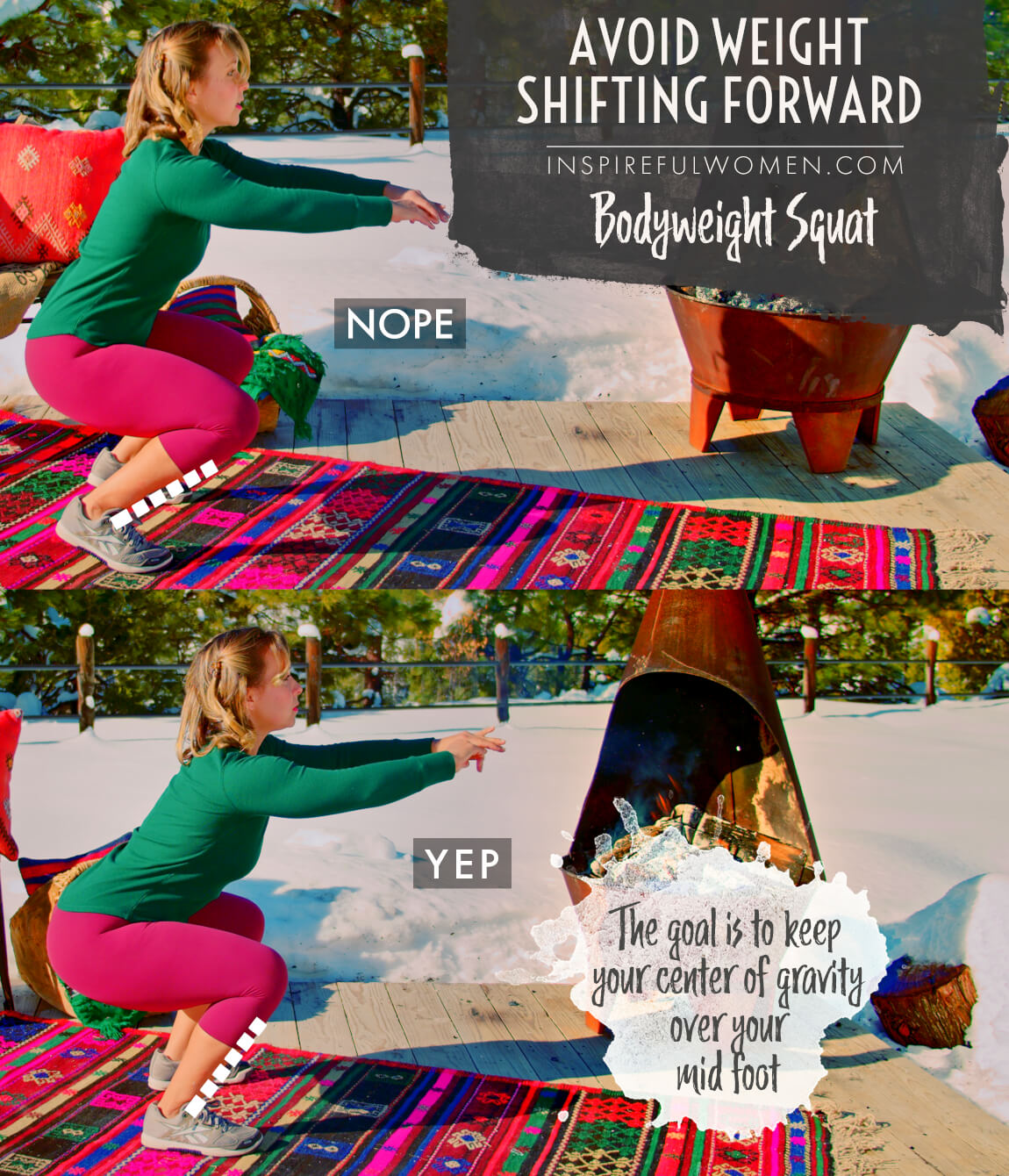
3. Avoid Knee Alignment
AVOID: Letting your knees collapse in - during any part of the movement.
WHY NOT?
- The knee joint should be in a line with the toes, shin, and thigh.
WHAT TO DO:
- Pay attention to this alignment on the way down and on the way up.
- This requires activation of the gluteus medius muscles to hold the thighs out.
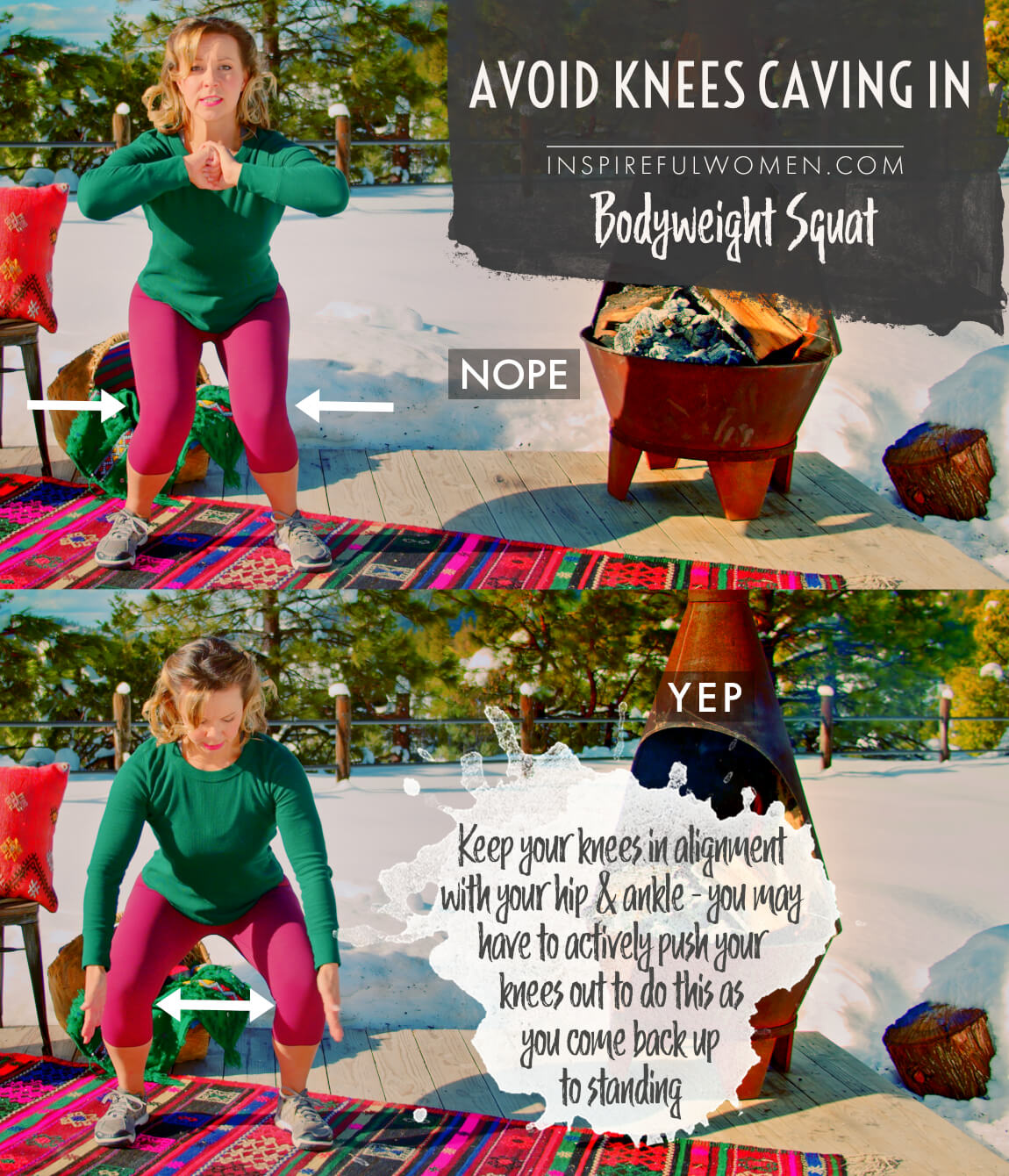
4. Avoid Dropping Down
AVOID: Just passively dropping down.
WHY NOT?
- This can cause pain to your knee joints.
WHAT TO DO:
- Engage your front hip flexors muscles to control your lowering. This will help stabilize your torso and stay upright.
5. Avoid Too Much Too Soon
AVOID: Doing too much too soon.
WHY NOT?
- Squats are a challenging exercise that can cause knee pain if you progress the exercise too quickly, this includes:
- Using too much resistance
- Doing too many reps.
- Trying to go too deep when you don’t have the strength or flexibility yet.
WHAT TO DO:
- Start slowly, do one set of 8 and see how you feel the next day.
- If the squats caused pain, the next time, review your form and try doing only 4 reps.
- Increase by 2 reps each time you do squats.
- If the squats caused pain, the next time, review your form and try doing only 4 reps.
6. Avoid Torso Moving Down
AVOID: Torso leaning too far over.
WHAT TO DO:
- Keep your sternum lifted, chest open.
- Keep your spine from head to tailbone in neutral throughout the movement.
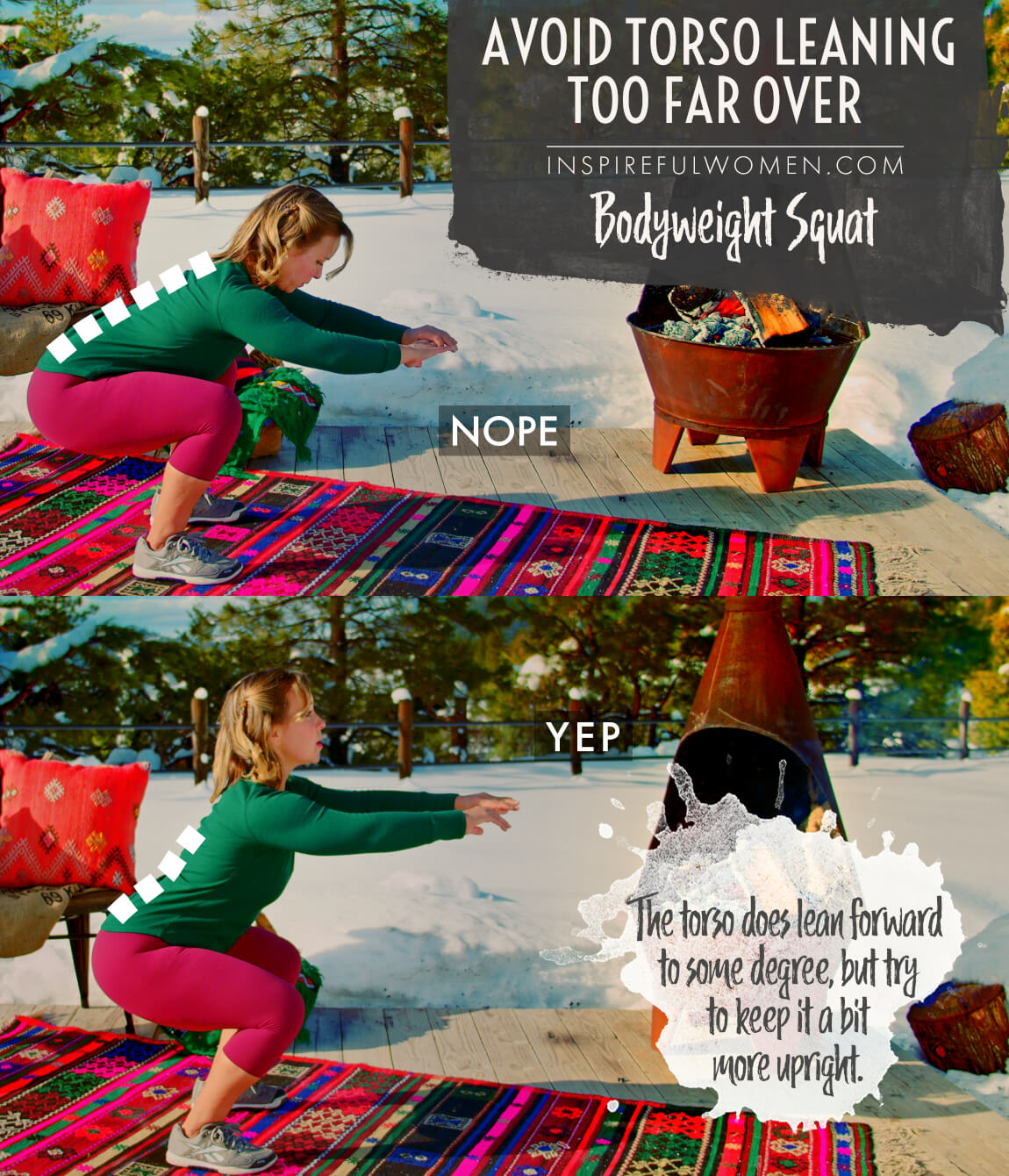
SCIENCY STUFF
SCIENCY STUFF
SPIFFILICIOUS FACTS ABOUT MUSCLES & MOVES
How far you should squat is a topic that has been studied a lot, and unfortunately, there are a lot of controversial findings. Some argue that the joint forces are too great when you do deep squats and that force increases when you are using weights. Others state that squatting down further is functional and is a position that has been used by many cultures for years. Furthermore, if you use the muscles and joints through a larger range of movement, you can develop the strength needed to protect the knee from injury. Following some basic common sense rules, it seems to make sense to start with no weight, focusing on getting the correct form and listening to your body - during the exercise and after the exercise (even two days after the exercise). If your goals are to improve your motor control, core strength, and joint movement, you may be very happy just sticking with bodyweight squats. If your goal is to be able to lift more weight, in order to protect your joints from damage it makes sense that you would need to train the body to tolerate lifting heavier loads. Start with very small weights, and progress slowly. Always paying attention to form and how your body responds. People get hurt when they add too much resistance or do too many reps too quickly. You should follow these guidelines for all exercises - start small (this means movement and resistance) and do a low number of reps - it should almost feel too easy. And progress slowly - increasing the movement, adding resistance, or adding reps. And always listen to your body. It is far easier and more fun to slowly improve than it is to push too hard and end up injured and needing to stop or even seek medical attention.
Activating the iliopsoas to pull your body down increases the stability of the core (it originates on the lumbar spine). Exhaling as you squat will engage the muscles of the pelvic floor and diaphragm to help stabilize the core by increasing the intra-abdominal pressure (it also helps to do a Kegel). [The Valsalva maneuver (exhaling forcibly and holding) is frequently recommended by weightlifters, this is not recommended as it can stress the cardiovascular system]. This becomes more important as you lift more weight.
ALLLL MUSCLES & WHEN
ALL MUSCLES WORKING & WHEN DURING Squats - Weights on Shoulders
In the starting position, the muscles of the core (transverse abdominis, obliques, erector spinae, multifidi, rectus abdominis) work to hold the spine in neutral. The scapular muscles are working isometrically to hold the shoulder blades together and down the back.
To place dumbbells at the shoulders: the biceps contract concentrically to bend the elbows.
The iliopsoas and rectus femoris (hip flexors) act concentrically to flex the hip to pull your body down. The quadriceps and gluteus maximus can help (eccentrically) to control the movement as you squat down.
In the full squat position the gluteus maximus (hip extension) and quadriceps femoris (knee extension), gastrocnemius, and soleus (plantar flexion - pulls the tibia back) contract concentrically to push the body back up to the starting position. The thigh adductors work to pull the thighs together, the adductor magnus also helps with hip extension. The soleus and gastroc contract concentrically to pull the tibia (shin bone) back to vertical.
PIN IT FOR LATER!
